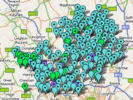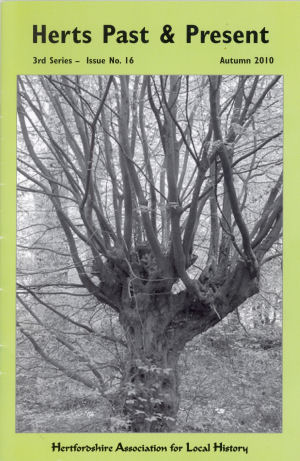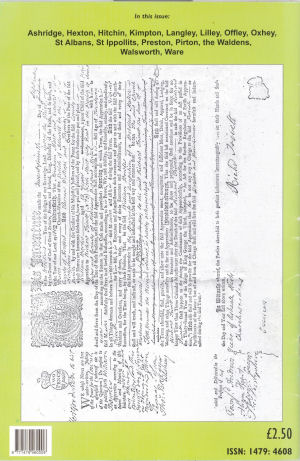|
|
Herts Past and Present Hertfordshire Association for Local History Autumn 2010 - No 16 |
|
|
In This Issue Ashridge, Hexton, Hitchin, Kimpton, Langley, Lilley, Offley, Oxhey, St Albans, St Ippollits, Preston, Pirton, the Waldens, Walsworth, Ware
|
Brief Guide to Sources: Apprenticeship Indentures - by David Short | |
| Lydia Hope's inventory of paintings and Charles I's art collection - by Sylvia Beare | ||
| When Lydia Hope, a well-to-do widow living in St Albans, died in 1691 she left an inventory recording thirty-four paintings, many of them 'large'. Their titles and descriptions led to a search for their origin. The conclusion is that many of the paintings came from the sale of King Charles I's art collection in 16491651.
Lydia bequeathed them to her grandson and their fate has not been
traced, although it seems likely that they soon returned to the London art market. George and Lydia Hope of St Albans and St Giles-in-the-Fields, London, 1628-48 The widow Lydia and her picture collection Where did Lydia's collection come from? Lydia sued in the court of Chancery The sale of the Royal collection Reassembly of a royal collection What happened to Lydia's collection? Edward Cole: a grateful grandson |
||
| Some of Hertfordshire's Special Trees - by Rachel Sanderson | ||
| The Special Trees and Woods Project, which is part of the Chiltern Woodlands Project and funded by the Heritage Lottery, is celebrating its fourth anniversary. Over the last four years an enthusiastic team of volunteers have recorded their favourite trees and woods across the Chilterns and the stories which are associated with them. It is often the stories that make the trees special and the stories often relate directly to our landscape history. | ||
| The Great Bed of Ware: A Literary History - by David Perman | ||
|
The Victoria & Albert Museum has agreed in principle to lend the Great Bed to Ware Museum for Olympic Year, 2012. If funds can be raised for the cost of insurance, etc., the return of the bed to Ware will be another stage in its extraordinary journey between five of the town So inns, then to Rye House and finally, in 1931, to the V &A. The literary history of the Great Bed is also extraordinary. Size, naughtiness and ghosts An advertising gimmick? Restoration drama Journalists and tittle-tattle Novelists and the Great Bed A Covent Garden pantomime, 1839, and a mistaken history The county historians attempt to correct the story The Dickens connection Saved for the nation, 1931 Twentieth-century accounts of the bed |
||
| Property ownership in twelve Hertfordshire parishes in the nineteenth century - by Nigel Agar | ||
| This analysis of a sanitary inspector's report on the Rural District of Hitchin in 1877 reveals some interesting information about social change in twelve nearby villages and is evidence of the decline of the squirearchy and rise of property ownership among the middling classes. By that time only two out of twelve villages could be still regarded as 'close' villages with a dominant
landlord squire. The other ten showed a wider variety of types of
cottage owner - bakers, chemists, farmers, bankers, publicans, women
and outsiders. The myth of the agricultural labourer living in his
tied cottage is challenged with the thought that farmers had
sufficient control over their workers without the need to be their landlords. Open and close parishes The 1877 Survey for the Rural Sanitary District of Hitchin Hexton and Lilley, two close parishes Open parishes: Ickleford Offley - an open parish Kimpton and the Waldens Pirton - a special case Ickleford, St Ippollits, Preston. Langley and Walworth Hexton, Lilley and Langley The myth of the labourer in his tied cottage Outsider Owners Charities as owners Women owners Springs, wells and drains: the problem of sanitation Owner-occupiers In Conclusion |
||
| Also editorial, news items, dates for the diary, and book reviews |



